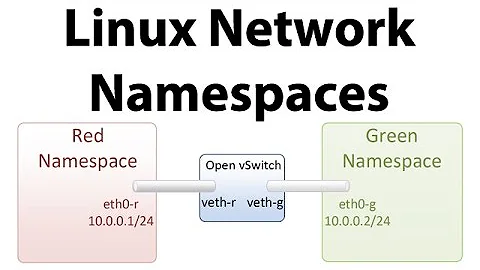VRF on Linux using network namespaces
Starting with kernel version 4.3 Linux has a VRF implementation. Checkout: https://www.kernel.org/doc/Documentation/networking/vrf.txt.
Related videos on Youtube
user349251
Updated on September 18, 2022Comments
-
user349251 almost 2 years
My ultimate goal is to implement Virtual Routing and Forwarding (VRF) in Linux. The method that seems to be most widely accepted is to set up different network name spaces (one for each separate routing table) and run a Quagga or BIRD daemon for each namespace/routing table. I'm not married to this method, so if anyone has any other suggestions, please let me know.
The machine in question is running Debian 7 (wheezy) inside VMware workstation 12. It has always been a router and has been successfully routing for a while before I started this reconfiguration, so I know that the general routing setup is good.
The immediate problem is that I cannot communicate through my network namespace. That is, veth1 (which is in my namespace as below) can ping ONLY veth0 and nothing else. There is no network communication between veth1 and the networks below it - not even ARPs. If I didn't know better, I'd say someone had pulled the cable from the switch (but it's kind of hard to do that in virtual environment). And yes, I checked that the vmnets were properly set up. The router works when restored to its old configuration. It just doesn't work in this new configuration.
Anyone have any idea how to get veth1 communicating? Or even a wholly different method to get VRF working on Linux? Thanks in advance.
I set up the new configuration as follows:
add namespace
ip netns add nsxadd virtual interfaces
ip link add veth0 type veth peer name veth1create a bridge
ip link add name vbr0 type bridgeadd eth1 AND veth1 to the bridge
ip link set dev eth1 master vbr0 ip link set dev veth1 master vbr0Assign veth1 to the namespace
ip link set veth1 netns nsxconfigure the veth's IPs
ip addr add 10.0.2.10/24 dev vbr0 ip addr add 10.0.2.1/24 dev veth0 ip netns exec nsx ip addr add 10.0.2.2/24 dev veth1Bring the i/f's up
ip link set dev vbr0 up ip link set dev veth0 up ip netns exec nsx ip link set dev veth1 upassign veth2 its own routing table
ip netns exec nsx ip rule add dev veth1 table 1Set the default route for the vtable
ip netns exec nsx ip route add default via 10.0.2.1 dev veth1You can see in the output of iptables-save that everything is set to ACCEPT or FORWARD as appropriate
output of ip addr show:
1: lo: <LOOPBACK,UP,LOWER_UP> mtu 16436 qdisc noqueue state UNKNOWN link/loopback 00:00:00:00:00:00 brd 00:00:00:00:00:00 inet 127.0.0.1/8 scope host lo inet6 ::1/128 scope host valid_lft forever preferred_lft forever 2: eth0: <BROADCAST,MULTICAST,UP,LOWER_UP> mtu 1500 qdisc pfifo_fast state UP qlen 1000 link/ether 00:0c:29:10:e0:01 brd ff:ff:ff:ff:ff:ff inet 192.168.26.5/24 brd 192.168.26.255 scope global eth0 inet 192.168.26.0/24 brd 192.168.26.255 scope global secondary eth0 inet6 fe80::20c:29ff:fe10:e001/64 scope link valid_lft forever preferred_lft forever 3: eth1: <BROADCAST,MULTICAST,UP,LOWER_UP> mtu 1500 qdisc pfifo_fast master vbr0 state UP qlen 1000 link/ether 00:0c:29:10:e0:ed brd ff:ff:ff:ff:ff:ff inet 10.0.0.1/24 brd 10.0.0.255 scope global eth1 inet6 fe80::20c:29ff:fe10:e0ed/64 scope link valid_lft forever preferred_lft forever 47: veth0: <BROADCAST,MULTICAST,UP,LOWER_UP> mtu 1500 qdisc pfifo_fast state UP qlen 1000 link/ether ce:63:69:82:73:35 brd ff:ff:ff:ff:ff:ff inet 10.0.2.1/24 scope global veth0 inet6 fe80::cc63:69ff:fe82:7335/64 scope link tentative valid_lft forever preferred_lft forever 48: vbr0: <BROADCAST,MULTICAST,UP,LOWER_UP> mtu 1500 qdisc noqueue state UNKNOWN link/ether 00:0c:29:10:e0:ed brd ff:ff:ff:ff:ff:ff inet 10.0.2.10/24 scope global vbr0 inet6 fe80::20c:29ff:fe10:e0ed/64 scope link tentative valid_lft forever preferred_lft foreveroutput of ip route show:
default via 192.168.26.2 dev eth0 10.0.0.0/24 dev eth1 proto kernel scope link src 10.0.0.1 10.0.2.0/24 dev vbr0 proto kernel scope link src 10.0.2.10 10.0.2.0/24 dev veth0 proto kernel scope link src 10.0.2.1 192.168.26.0/24 dev eth0 proto kernel scope link src 192.168.26.5output of ip netns exec nsx ip addr show:
45: lo: <LOOPBACK> mtu 16436 qdisc noop state DOWN link/loopback 00:00:00:00:00:00 brd 00:00:00:00:00:00 46: veth1: <BROADCAST,MULTICAST,UP,LOWER_UP> mtu 1500 qdisc pfifo_fast state UP qlen 1000 link/ether b6:27:40:06:c2:de brd ff:ff:ff:ff:ff:ff inet 10.0.2.2/24 scope global veth1 inet6 fe80::b427:40ff:fe06:c2de/64 scope link tentative valid_lft forever preferred_lft foreveroutput of ip netns exec nsx ip route show
default via 10.0.2.1 dev veth1 10.0.2.0/24 dev veth1 proto kernel scope link src 10.0.2.2output of iptables-save
# Generated by iptables-save v1.4.14 on Thu Apr 14 18:19:19 2016 *nat :PREROUTING ACCEPT [36:3588] :INPUT ACCEPT [32:2540] :OUTPUT ACCEPT [51:3744] :POSTROUTING ACCEPT [55:4792] COMMIT # Completed on Thu Apr 14 18:19:19 2016 # Generated by iptables-save v1.4.14 on Thu Apr 14 18:19:19 2016 *filter :INPUT ACCEPT [3319:373389] :FORWARD ACCEPT [8:2004] :OUTPUT ACCEPT [3558:428447] COMMIT # Completed on Thu Apr 14 18:19:19 2016




